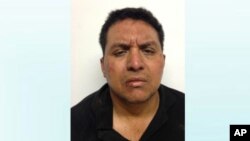HOUSTON —
The arrest of one of Mexico's most notorious and brutal drug cartel leaders is being hailed as a major victory for the Latin American country's president, Enrique Pena Nieto and the U.S.-Mexico cooperative program to fight drug trafficking. But the capture of the leader of the Zetas kingpin is also a gain for his rivals in the illicit trade.
Mexican Marines apprehended Miguel Angel Trevino on a road south of Nuevo Laredo, which sits on the U.S. border across from Laredo, Texas. The reputed leader of Los Zetas was with two associates in a car that contained large amounts of cash, automatic weapons and ammunition.
The security spokesman for Mexican President Enrique Pena Nieto, Eduardo Sanchez Hernandez, says Trevino is facing a long list of charges in Mexico.
He says the charges include involvement in organized crime, murder, torture, possession of illegal firearms, money laundering and the murder of immigrants from Central America and elsewhere who were kidnapped by the Zetas.
Coming one year after the Mexican military killed the former head of the Zetas, this is a strong blow to the criminal organization and a grand prize for the Mexican government. But Mexico expert George Grayson, who teaches at the College of William and Mary and who wrote a book on the Zetas, says the real beneficiary may be Mexico's top drug lord.
“The big winner is (Joaquin) El Chapo Guzman, who is head of the Sinaloa cartel, because he has been trying for years to gain access to Nuevo Laredo, which is the major portal for shipping goods, services, drugs, illegal immigrants and cash between Mexico and the United States," he said.
Grayson says the Zetas, which began as a renegade military outfit that provided protection to the Gulf cartel along Mexico's eastern border with the United States, no longer operates with a vertically structured command.
"Los Zetas have lost most of their founders and most of their key regional leaders. Over the years, they have evolved from a vertical organization, with an extremely competent control and command capability, into McDonald's-like franchises," he said.
The loose structure may have contributed to reckless acts of violence that have made the Zetas the most hated and feared organized crime group in Mexico.
Miguel Angel Trevino is an example of the "new" Zetas, who have no military background. He was born in Mexico, but raised around Dallas, Texas and went back to Mexico as a young man to earn a reputation as a ruthless killer. According to indictments against him in the United States, his brother once told an informer that Miguel Angel Trevino had killed more than 2,000 people, including 385 U.S. citizens.
Trevino also is accused of ordering the murder of more than 260 migrant workers, mostly from Central America, whom the Zetas kidnapped as they made their way north to the U.S. border in 2010. Grayson says the gang often obtained as much ransom money as possible from relatives of kidnapped migrants before trying to force them to work for the gang.
"In addition to extorting them, they would also recruit them as possible lookouts, couriers and maybe, ultimately, gunmen. And if they resisted, they would bash their heads in with sledge hammers. Cruelty, meanness, sadism was the brand of Los Zetas," he said.
In the United States, there are federal indictments against Miguel Angel Trevino for drug trafficking and weapons violations. A few years ago, the U.S. government issued a $5 million reward for information leading to his arrest.
George Grayson says it is very likely that intelligence from U.S. law enforcement agencies played a role in guiding the Mexican Marines to his location in northern Mexico.





